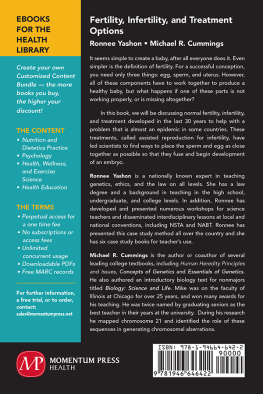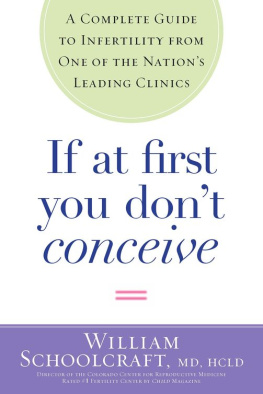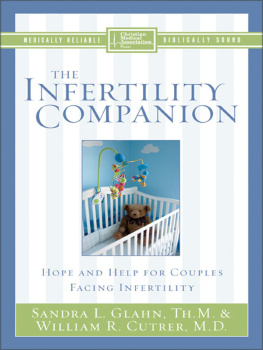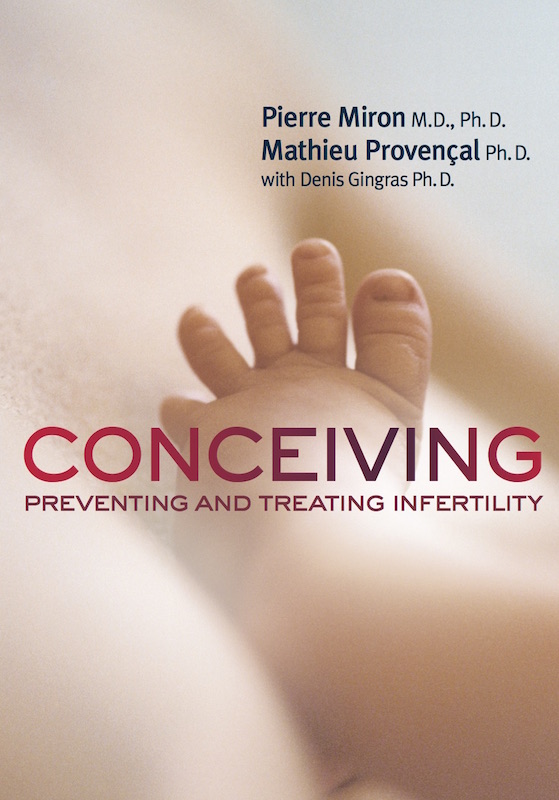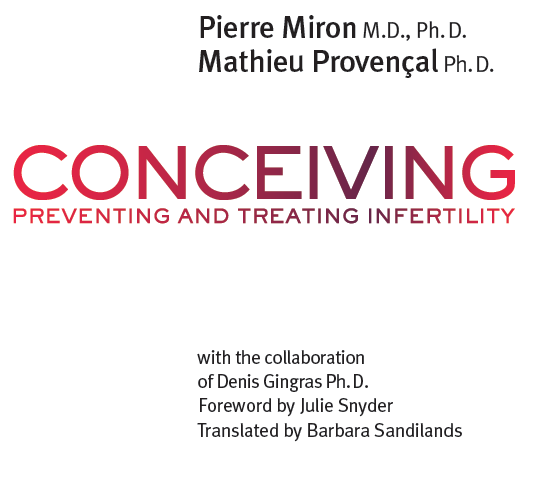Copyright
Copyright 2015 Les ditions du Trcarr
Originally published as Conevoir : prvenir et traiter linfertilit.
Published under arrangement with Groupe Librex Inc., doing business under the name ditions du Trcarr, Montral, QC, Canada
All rights reserved. No part of this publication may be reproduced, stored in a retrieval system, or transmitted in any form or by any means, electronic, mechanical, photocopying, recording, or otherwise (except for brief passages for purposes of review) without the prior permission of Dundurn Press. Permission to photocopy should be requested from Access Copyright.
Editor: Michael Melgaard
Design: Laura Boyle
Epub Design: Carmen Giraudy
Cover Image: Steffen Thalemann/ Image Bank/ Getty Images
Library and Archives Canada Cataloguing in Publication
Miron, Pierre, 1957- [Conevoir. English]
Conceiving : preventing and treating infertility / Dr. Pierre Miron, Mathieu Provenal, and Denis Gingras, PhD ; translated by Barbara Sandilands.
(Your health ; 4) Translation of: Conevoir, prvenir et traiter linfertilit.
Includes bibliographical references. Issued in print and electronic formats.
ISBN 978-1-4597-3007-6 (pbk.).--ISBN 978-1-4597-3008-3 (pdf).--ISBN 978-1-4597-3009-0 (epub)
1. Infertility--Prevention. 2. Infertility--Treatment. 3. Reproductive health. I. Gingras, Denis, 1965-, author II. Provenal, Mathieu, 1979-, author III. Sandilands, Barbara , translator IV. Title. V. Title: Conevoir. English
RC889.M5713 2015 616.692 C2015-900597-3
C2015-900598-1
We acknowledge the support of the Canada Council for the Arts and the Ontario Arts Council for our publishing program. We also acknowledge the financial support of the Government of Canada through the Canada Book Fund and Livres Canada Books, and the Government of Ontario through the Ontario Book Publishing Tax Credit and the Ontario Media Development Corporation.
Care has been taken to trace the ownership of copyright material used in this book. The author and the publisher welcome any information enabling them to rectify any references or credits in subsequent editions.
J. Kirk Howard, President
The publisher is not responsible for websites or their content unless they are owned by the publisher.
Visit us at: Dundurn.com
@dundurnpress
Facebook.com/dundurnpress
Pinterest.com/dundurnpress
Dedication
To our parents, who gave us life;
To our spouses, who make it more wonderful every day;
And to our children, whom we love so much and through whom it continues.









CHAPTER 8
Conceiving a Child
Every apple is a flower tha t has known love.
Flix Leclerc ( 1914 1988 )
Reproduction is such a natural process that couples who experience difficulty conceiving a child are always taken by surprise when their attempts fail repeatedly. Disappointment, sadness, anxiety, and sometimes even a feeling of unfairness over the time its taking them to conceive can greatly disrupt these couples lives, while leaving them confused as to the steps to take in the hope of achieving their dreams of having a child.
These feelings are completely justified, but its important to remain positive in the face of the challenge posed by a difficulty in conceiving. There are, in fact, a number of lifestyle changes that can significantly improve fertility, and putting these preliminary steps into practice may in many cases be enough to resolve the problem. Nor must the hope of conceiving a child be abandoned even when infertility is caused by major physiological disorders: reproductive medicine is a constantly evolving field, able to treat a significant number of hormonal and anatomical disorders, and these techniques now enable millions of people to conceive a child.
In conclusion, we would like to provide a brief overview of the main factors scientifically recognized to influence fertility, as well as the available medical procedures to overcome male and female reproductive system abnormalities.
. MAKE LOVE OFTEN !
This may seem obvious, but its important to remember that the frequency of sexual relations has a direct effect on the likelihood of conceiving a child. In the short term, such a requirement does not usually pose a problem; however, for couples who have to come to terms with repeated failures to conceive, maintaining a high level of sexual activity can become emotionally difficult in the longer term, and its tempting to space out intercourse by programming it to take place at a time when success is most likely.
This kind of synchronization can, however, be harder to achieve than is generally thought. Most pregnancies are the result of intercourse that took place within a short phase of the menstrual cycle, beginning five days before ovulation and ending immediately after ovulation has occurred (figure 54). Sexual relations that occur during the last three days of this critical period (the day of ovulation and the two days beforehand) are linked to the highest probability of conception.
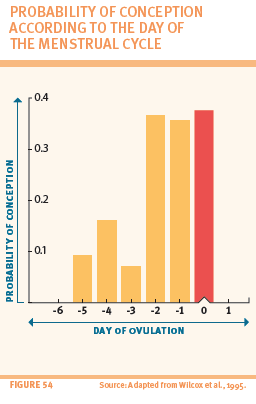
However, this optimal fertility window varies greatly from one cycle to another, even in women with regular cycles. A 28-day cycle, for example, does not automatically mean ovulation on day 14 and, therefore, a fertile period starting on day 9 or 10; in practice, studies show that 70 percent of women can be fertile before day 10 and after day 17 of the cycle. As a result, its usually hard to guess the exact time of optimal fertility and limit intercourse to this period, especially when cycles are irregular. Obviously, regular menstrual cycles longer than 35 days usually require medical consultation right from the start.




